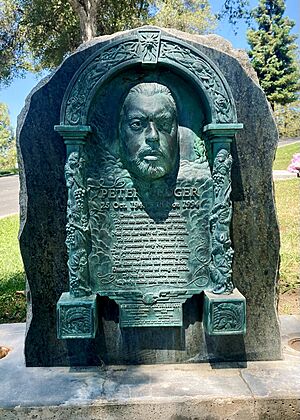Peter Ledger facts for kids
Quick facts for kids
Peter Ledger
|
|
|---|---|
| Born | 25 October 1945 Sydney, New South Wales, Australia |
| Died | 18 November 1994 (aged 49) Oakhurst, California, United States |
| Occupation |
|
| Nationality | Australian |
| Period | 1970s–1994 |
Peter Ledger (born October 25, 1945 – died November 18, 1994) was a talented Australian artist. He was known for his work as a cartoonist, comic book artist, and illustrator. Peter Ledger was especially famous for his detailed airbrush art and amazing fantasy pictures.
Contents
Who Was Peter Ledger?
Peter Ledger was a very interesting person with many different skills and hobbies. Besides studying art, he worked with surveying teams in the Australian outback. He also hunted deer in New Zealand and was a professional scuba diver. He even made leather goods and was a great cook! Peter loved adventure; he raced motorcycles, flew hot air balloons, and was a bodybuilder. Later in his life, he became a private pilot.
Early Career and Awards
Peter Ledger became a top illustrator in Australia. People loved his detailed airbrush work and fantasy images. He created graphics for Australian films like Stone (1974) and Oz (1976).
In 1977, he won the "Art Directors Silver Award" for his Surfabout poster. That same year, one of his posters for Golden Breed, a surfing clothing brand, was featured in a special book of award-winning posters from around the world. In 1979, he won an "Australian King of Pop" award for designing the album cover for The Angels' album Face to Face.
Working with Comics and Movies
Around 1978 and 1979, Peter Ledger lived in New York. He worked for Marvel Comics, where he created fully painted and airbrushed art for the series Weirdworld: Warriors of the Shadow Realm.
In 1981, he moved to Los Angeles for a special art project. This project was a large art book about Uncle Scrooge McDuck: His Life and Times, written and drawn by Carl Barks. Peter Ledger was a big fan of Carl Barks' duck art. His job was to hand-paint and airbrush all the stories in the book.
That same year, he met writer Christy Marx again. They got married in March 1983. Together, they worked on many comic book, movie, and game projects for 13 years. They created comic book stories like Carlos McLlyr and the graphic novel The Sisterhood of Steel.
Peter also worked in the film and television industry. He drew storyboards, which are like comic strips that plan out movie scenes. He also designed creatures and painted robot suits for the movie The Ice Pirates. He even created the first logo for the TV show Babylon 5 and drew the first character pictures for it. His art helped J. Michael Straczynski sell the idea for the series.
A Love for Planes and Games
Since he was a boy, Peter Ledger loved planes, especially German planes from World War II. He was very interested in the jet aircraft developed during that war. In 1988, Peter and his wife traveled to Germany. There, a famous German World War II pilot, Adolf Galland, signed one of Peter's special aviation prints.
Around 1988, Peter and Christy started working on computer games for Sierra On-Line. Peter created the art for several games, including:
- Conquests of Camelot: The Search for the Grail (1990)
- Ringworld: Revenge of the Patriarch (1992)
- Blue Force (1993)
- Blood & Magic (1996)
From about 1990 onwards, Peter focused on creating large wall murals and trompe-l'œil paintings. Trompe-l'œil is a French term meaning "deceive the eye." These paintings create an optical illusion that makes flat surfaces look like they have depth or real objects. He worked with British artist Susie Wilson. They created many amazing trompe-l'œil works in California. Most of these are in private homes. However, some of their work could be seen at Castillo's Mexican Restaurant in Oakhurst, California, on the way to Yosemite National Park. These paintings included jungle scenes, desert scenes, parrots, and even a pterodactyl bursting through a painted window!
How Peter Ledger Died
Peter Ledger's wife, Christy Marx, shared details about his death. On the evening of November 18, 1994, Peter was driving home from Monterey to Oakhurst. He was on a dark country road. It is believed he either missed or did not stop at a stop sign at a blind corner. A large truck carrying cotton hit his car. Both vehicles were destroyed in the crash. The truck driver survived, but Peter Ledger died instantly. He was buried in a small, old cemetery in Oakhurst.
His gravestone has a bronze plaque of his face, which was made from a mold of his face. It also has a poem that Peter had written a few years before he passed away. His son, Julian Ledger, created many sculpted details on the gravestone.
Peter Ledger's Legacy
The Ledger Awards were created to honor Peter Ledger's important contributions to comic book art. These awards celebrate excellent Australian comic art and publishing. The Ledger Awards started in 2004 and ran until 2007. They were brought back in 2014 and continue to recognize talented artists today.


